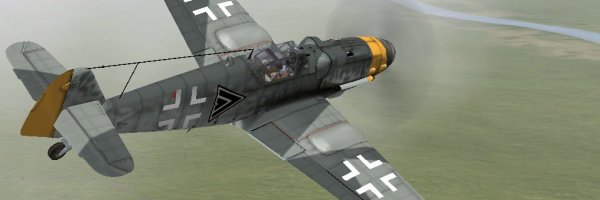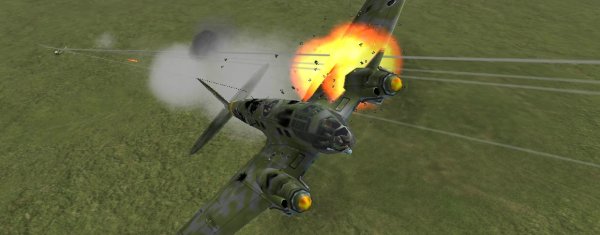Making Of: IL-2 Sturmovik
[This interview took place in a Manchester Hotel Bar, with Oleg chain-smoking and chuckling to himself all the while. He was also agreeably outspoken against most Flight Sims - usually while doing that chuckle - in a way which not many developers are about their peers. I have to applaud. This interview originally appeared in PC Format magazine, in the lead up to Pacific Fighters]
Assuming we put aside all the ones about giant harems and chocolate syrup, it’s arguable that the flight was man’s oldest fantasy. It took thousands of years to achieve, following the efforts of some of humanity's greatest minds. Then, for some, came the next challenge: successfully making something which offered a convincing facsimile of real flight. “It was my dream to make Flight Sims from the very beginning,” says the softly-spoken Oleg Maddox, whose English is far better than my Russian, “In 1993 though... the power of the PC just wasn’t enough. It was possible to make some little thing like Wing Commander, for example… but that’s not really a flight sim, because there’s no real physics and no real simulation of the movements.”
So while Oleg’s Maddox games formed in 1992, his plans were put on hold for technology to catch up so he could put his real-world talents – he’s an Aviation engineer graduate from the Moscow Aviation Institute, with eleven years of experience as lead designer for several Moscow military design bureaus – into a gaming environment. Maddox’s early years were about getting his team together. “Step by step I accumulated new programmers with Aviation experience, which graduated from the Moscow or Leningrad institutes, for example.” He says, “In 1996, we did our first arcade game. Then in 1998 we had already begun to look around flight sims, and saw European Air War released. I realised it was the time to make something and we could do it better than non-aviation engineers”.
The decision to centre the game around the soviet IL-2 came from the team’s environment. “Since we were making it in Russian, and a Russian publisher we decided to make it for the Russian marketplace,” Oleg notes, “It was originally planned to make just one playable aircraft.” This soon changed, as Oleg went out and talked to investors and the future-players on forums. First a playable German plane was included, but the roster slowly expanded. “A lot more Russian and German aircraft,” adds Oleg , “And so was born IL-2.”
From the moment they’d decided to head towards IL-2, they had a head start given a project that disappeared into the ether. “At the same time we had the order from the government to make a training simulation for military aircraft. This work was canceled, but the work around it was used to make IL-2,” says Oleg, “They came back but, but it was too late – and the whole thing was switched for the game market.” This flirtation with authentic simulators continues to the present day. “Just a few days ago, I had an e-mail from Latvia where pilots asked to make them a simulator for Russian aircraft. But I said that I can’t do it – I’m busy with other projects,” says Oleg. “Several flight schools have made similar requests,” he says, “but it’s not interesting for us in terms of funding”.
Oleg’s dream has to make a decent flight simulator. But what is it about them which enchanted him? “Because I wasn’t able to fly real aircraft all the time,” he laughs, “Now I can, but in the past it wasn’t possible.” It’s a dream that, for him, has come completely true. What does he love in IL-2? “Everything,” he grins, “Absolutely everything.” But asked to narrow it down, it’s the Physics which he thinks they pushed hardest. “We did almost everything to the edge of what was conceivably possible,” he notes, “There’s some compromise. We could make one plane, with no environment and do it at very high level, with much better physics without much simplification… but it would just be that, and nothing more. It couldn’t handle anything else. We needed the good graphics. The good artificial intelligence. The good visual effects. And a hundred aircraft in the air. We were always aware that we needed to compromise in some part to make another part work. I’d like to say that IL-2 was a big lot of compromises in coding.” It's easy to argue that choosing what compromises are acceptable is, of course, the core of game design.
In terms of what went wrong, it was the human and time dimensions. It simply took longer than they’d desired. “Because it’s all human resources limited,” he says, visibly tired, “Sometimes we’re working twenty-five hours a day. Sometimes. We all got very tired. And now we need to spend more and more time because the code is increasingly complex, with a lot of cross-functions. If you make a mistake in one part, it outputs in another part as well. Sometimes we just don’t know whether it’s working or not, and spend a week finding it. It’s a very big program. A very complex program.” As they head towards sequels, they’ll be using the well tested code base as a solid foundation to build on.
But there’s other lessons learned from the process. Oleg’s come to a better understanding of Maddox’s fanbase. “Users don’t like to wait,” he states, simply, “Another would be that the more we give, the more users expect – even if they don’t understand how much effort it is. And the more you give for free, the more people ask for free. They’re crazy when we begin to sell the product not for free.”
IL-2’s community is one of its greater assets, and one which Maddox tried to cultivate, even if they didn’t realise how big it would be. “I didn’t expect it to be like this,” Oleg says, “but from the beginning of development, from the initial scenes, from when I started going on forums and asking users what they needed, I changed development during it to make this thing which would satisfy all the groups of users.”
“Of course, that isn’t possible. Some will like a combat game. Some people like a clean flight sim. One will like all features from an aircraft to be featured. One will prefer to go through the entire aircraft check-list before he can fly… and that’s one thing that a real pilot /hates/. He likes to /fly/ only. But some people think realism is getting all the features working. Some flight sims in the past were so hard to fly that – me myself, a real pilot, and my friends, also real pilots – said that we’d never fly a real aircraft if they were anything at all like sims”
On a personal level, the amount of knowledge they’ve accumulated is toweringly impressive “I know more about manual aircraft than I’d ever thought I’d know,” he claims, “For example, in the Messerschmidt I know everything. In the Spitfire, I know about half. The Fokker Wulf, I know in detail, Screw by screw.” The time to gain such knowledge also impacts on development, and Oleg’s planned for more time to gather this information. And the more information they gain, the more they have to test that they’ve simulated it correctly. “For example, how the supercharger of an aircraft works,” he gives to illustrate their approach, “How many steps it takes? How it affects the engine at different altitude? All these differences have to be considered. We already simulate each cylinder for each aircraft and then run test battles with each engine to make sure it acts how it did. With new development, each time we do it it’s more complex.”
For Oleg, the fruits of this attention to detail can be seen in the quality of the IL-2 gamers. “There’s some part of the community who are very high level – aviation engineers, pilots – who speak in a different way to the kids,” he explains, “IL-2 has attracted those people, from around the world – from Japan, from Australia, from Russian, from Germany.” While this is clearly a badge of honour, this gathering of intelligent and knowledgeable fans has also fed back into the game. “This way I’ve found lots of people who help me – for example – develop pacific fighters,” Oleg claims, “I can spend much less time on research now, and still make a better product, a more specific product. Of course, it’s not possible to do everything, but at least we can use input to make things more correct.”




